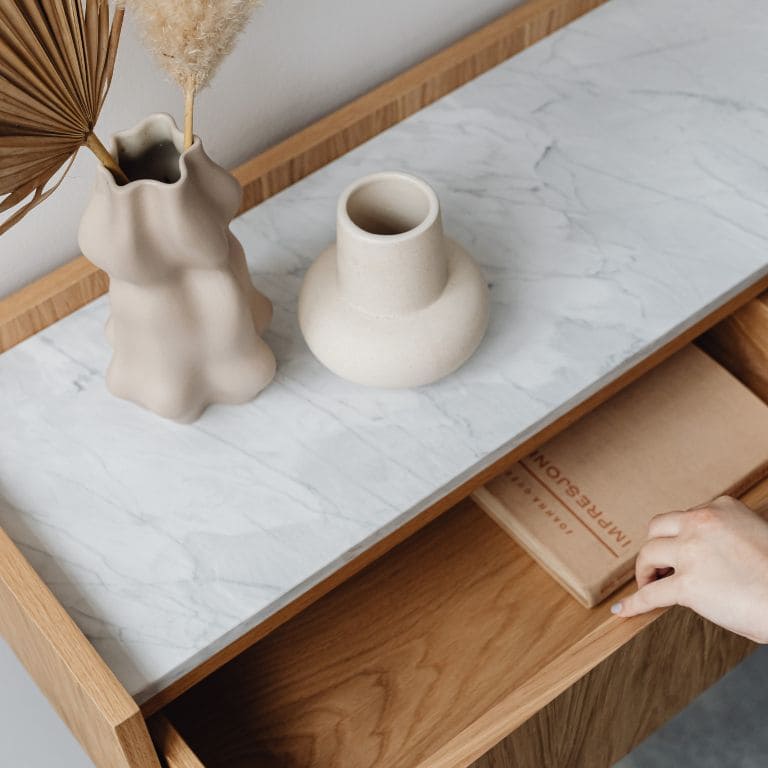Minimalism aims to simplify life in a world dominated by excess. By eliminating unnecessary things, we seek a deeper connection with what truly matters, leading to a more meaningful life.
In interior decoration, conscientiously choosing minimalist elements creates calmer environments that bring a sense of lightness.
The concept of a capsule wardrobe simplifies fashion and eliminates the stress of daily choices about what to wear.
In the digital environment, minimalism brings mental clarity and enhanced productivity by simplifying and organizing electronic devices, folders, emails, etc.
In nutrition, a minimalist diet tends to prioritize simple and nutritious foods, reducing consumption of processed foods, which promotes greater physical and mental well-being.
THE CONCEPT OF MINIMALISM
Before delving into specific examples, it’s crucial to understand what minimalism represents. At its core, minimalism goes beyond aesthetics or trendiness. It’s a life philosophy that seeks essence, simplicity, and clarity amidst today’s chaos.
Simplicity and Focus
Minimalism isn’t just about owning fewer material goods; it’s about a mindset of detachment and prioritizing what truly matters in life. By shedding excess and distractions, we find tranquility.
Less Is More Motto
We’re constantly bombarded with offers and tempted to acquire more things, pursue more success, more social status, etc. Minimalism serves as a kind of antidote. It reminds us that true happiness isn’t found in accumulating material things or in the relentless pursuit of more, but in valuing experiences and what we already have.
Finding Balance
Adopting a minimalist lifestyle doesn’t necessarily mean living in a bland, uncomfortable space. It’s about finding a healthy balance between sufficiency and excess, simplicity and quality of life. It’s about being mindful of our choices and learning to discern between the necessary and the superfluous in all areas of life.
EXAMPLES OF MINIMALISM IN PRACTICE
1. Minimalist Home Decoration
In the quest for a quieter and more serene environment, minimalist decoration emerges as a powerful ally. Interior decoration is the most striking area of minimalism and has the most visual impact.
In this practice, the focus is on simplicity and functionality of spaces. By opting for multifunctional furniture, neutral colors, and visual clutter-free designs, we create open and harmonious environments, allowing us to better focus on the present moment.
2. Capsule Wardrobe
The capsule wardrobe has gained popularity, embodying a minimalist approach to fashion with conscientious curation of clothing pieces, keeping only the essentials and discarding what is no longer used.
By maintaining only versatile, high-quality, and timeless pieces, we simplify our daily routine of choosing outfits. These pieces can be combined in various ways, offering a wide range of looks with a limited number of items.
3. Digital Minimalism
In an increasingly technology dominated world, digital minimalism has become a necessity. Simplifying life in the digital realm isn’t just about reducing screen time; it’s about establishing a healthy, balanced relationship with technology.
For example: organizing files on the computer, limiting access to social networks, organizing paperwork in filing systems, eliminating unnecessary paperwork, tidying up the work desk, keeping passwords in a secure place, deleting or canceling accounts that are no longer useful, organizing the email inbox, etc. These are some steps towards peace of mind and increased productivity.
4. Minimalist Eating
Minimalist eating goes beyond simply choosing healthy foods; it involves adopting a more conscious approach to nutrition, prioritizing simple, natural, fresh, and nutritious ingredients while minimizing consumption of processed and packaged foods.
It’s possible to create delicious and practical meals without relying on industrialized ingredients, valuing the quality of food to achieve a more mindful and balanced diet. Good nutrition helps promote both physical and mental health.
5. Minimalism in the Workplace
Applying minimalist principles in the workplace is a key strategy for increasing efficiency and productivity, as well as reducing stress and anxiety.
Organizing the workspace in a smart and minimalist manner helps manage time wisely and prioritize tasks according to their importance. By simplifying work activities, it’s possible to achieve greater focus and accomplish tasks more effectively.
CONCLUSION
Minimalism is a holistic approach to life that invites us to rethink our priorities and seek simplicity in an increasingly complex and materialistic world.
A Life Philosophy
Minimalism isn’t just about owning fewer things; it’s about cultivating a mindset of detachment and prioritizing the essentials. It’s about freeing ourselves from the burden of excess and distractions to focus on what truly matters. By simplifying things, we can find greater mental clarity and less stress.
Inspiration for Change
We hope the examples presented throughout this post have inspired you to embrace minimalism in your life. Whether in decorating your home, managing your wardrobe, organizing your office or workplace, or adjusting your diet, there are countless opportunities to simplify and focus on what truly matters. By adopting a minimalist lifestyle, you may discover a new sense of freedom and purpose.
Living with Less Means Living with More
Living with less doesn’t mean sacrificing comfort or quality of life; on the contrary, it can pave the way for a fuller and more meaningful existence. Minimalism invites us to detoxify and focus on what truly matters, bringing more harmony and balance to our days.
Minimalism is a personal journey where each person finds their own path, and we hope this post has been the first step towards a simpler, more conscious, and more meaningful life.
FAQ
- What Is Minimalism Example? Minimalism example refers to practical demonstrations of how minimalism can be applied in different areas of life, such as decoration, lifestyle, work, and eating. These examples illustrate how living with less, simplifying, and focusing on the essentials can result in a more significant and fulfilling life.
- What Are Minimalist Habits? Minimalist habits are daily practices that emphasize simplicity, intentionality, and detachment. This can include reducing consumption, conscientious organization, prioritizing meaningful activities, and eliminating unnecessary distractions.
- How to Apply Minimalism in Life? To apply minimalism in life, it’s essential to evaluate and simplify all areas of life, from material possessions to commitments and daily routines. This involves letting go of excess, prioritizing what truly matters, and cultivating a mindset of gratitude and contentment with less.
- How Do Minimalists Live? Minimalists live in a simplified way, detached from excess and focused on the essentials. They value experiences over possessions, quality over quantity, and freedom over material attachments.
- How to Identify a Minimalist Person? A minimalist person can be identified by their conscious and intentional approach to life. They tend to have an organized home with few excesses, a simplified lifestyle, and a mindset focused on what truly matters.
- What Is the Main Characteristic of Minimalism? The main characteristic of minimalism is simplification. It’s about reducing excess in all areas of life to focus on what is essential and meaningful.
- How to Be Minimalist and Consume Less? Being minimalist and consuming less involves rethinking consumption habits, prioritizing quality over quantity, opting for durable and essential products, and avoiding impulse purchases.
- What Is Minimalist Beauty? Minimalist beauty refers to a simplified and uncomplicated aesthetic characterized by elegance and careful use of basic elements. In makeup and design, for example, this can mean neutral tones, clean lines, and a subtle approach.
- How to Make Your Home More Minimalist? To make your home more minimalist, it’s important to let go of unnecessary items, maintain efficient organization, choose functional furniture and decorations, and focus on creating spacious, distraction-free spaces.
- What Is a Minimalist Room? A minimalist room is a quiet space devoid of distractions, designed to promote relaxation and rest. It’s characterized by simple and functional furniture, a palette of soft colors, and practical and efficient organization.
- How to Build a Minimalist Wardrobe? To build a minimalist wardrobe, start with a complete cleanout and organization, eliminating all unnecessary pieces. Then, choose versatile and high-quality pieces that can be combined in various ways, creating a collection that is functional and timeless.








